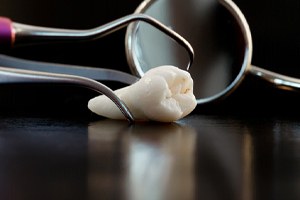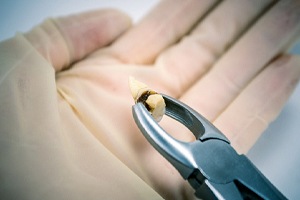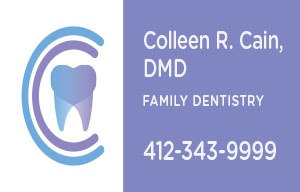Tooth Extractions
Removing Badly Damaged Teeth and Protecting the Rest

Tooth extractions in Castle Shannon are never the first choice, but sometimes they’re the only choice. Maybe you have a cavity that went untreated for too long, or there was an accident that severely damaged the tooth beyond what a crown could fix. In these cases, Dr. Colleen will make sure that the extraction process is as comfortable for you as possible. If you have a tooth that’s causing severe pain, contact our office as soon as possible so that we can determine a necessary course of action.
Why Do I Need an Extraction?

Ideally, all your teeth should last as long as possible, but you might need to have one extracted for any of the following reasons:
- A Tooth That’s Beyond Saving: A tooth that is too damage or decayed to be repaired will need to be removed altogether.
- Crowding: If you need an orthodontic treatment, it might not work if your teeth are too crowded together.
- Infection: An infected tooth can often be treated with root canal therapy or antibiotics, but if the infection is severe an extraction may be the only way to stop it from spreading. Untreated gum disease can also ultimately lead to tooth removal.
- Impacted Tooth: Sometimes a tooth (especially a wisdom tooth) can’t break through the gums, and extracting it could be the best way to avoid damage to your other teeth.
The Tooth Extraction Procedure

The procedure will be different depending on whether you need a simple extraction or a surgical extraction.
Simple extraction is for fully erupted teeth that can clearly be seen when you open your mouth. After the nearby area is numbed, the tooth is elevated and loosened as needed using special instruments. We will then use forceps to move it back and forth before it can be removed altogether.
For less accessible teeth (such as those that haven’t erupted or are broken under the gum line), surgery is needed. We will need to make incisions in the soft tissue surrounding the tooth; sometimes we will also need to remove some bone. Once we have access to the tooth, it might be necessary to break it into several pieces in order to safely be removed. An appropriate form of dental sedation will be used to keep discomfort at a minimum during the procedure.
Aftercare for Tooth Extraction

It can take around 7 to 10 days for the site of the extraction to heal. A blood clot will form in the socket; make sure it stays in place, or else it could be very painful and slow down healing.
You should generally plan to rest for at least 24 hours after the extraction. After the first day, you can rinse your mouth with 8 ounces of warm water mixed with half a teaspoon of salt. Take painkillers as directed; you can also use an ice bag, but don’t apply it for more than 10 minutes at a time.
